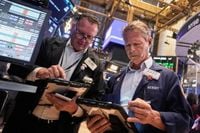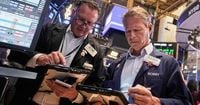On Friday, September 26, 2025, Wall Street ended a volatile week with a dose of optimism as major U.S. stock indexes rebounded, snapping a three-session losing streak. The S&P 500 rose by 0.6%, the Dow Jones Industrial Average climbed 0.7%—adding 299 points—and the Nasdaq composite gained 0.4%, according to the Associated Press. Despite this late-week rally, the indexes still finished lower for the week, a reminder of the underlying uncertainty that continues to shape markets.
The catalyst for Friday’s uptick was a closely watched inflation report. The Personal Consumption Expenditures (PCE) index, the Federal Reserve’s preferred gauge of inflation, showed prices increased 2.7% year-over-year in August, up from 2.6% in July. This result matched economists’ forecasts and marked the fourth consecutive month of accelerating inflation, as reported by Investopedia. Core inflation, which excludes volatile food and energy prices, also rose 2.9% annually in August. While inflation remains above the Fed’s 2% target, the lack of an upside surprise offered hope that the central bank could continue its gradual approach to interest rate cuts.
“The increase matched the expectations of forecasters, and the lack of a surprise inflation surge likely kept expectations in financial markets intact that the Fed will cut its key interest rate in October for the second time this year despite concerns that inflation is still higher than the central bank's target,” Investopedia noted. The Fed had just delivered its first rate cut of 2025 last week, but policymakers have been cautious about promising more, wary that further easing could stoke inflation even higher.
Bond markets reflected this measured optimism. The yield on the 10-year Treasury held steady at 4.18%, while the U.S. dollar index dipped 0.4% to 98.15. Gold futures advanced 0.7% to $3,795, and West Texas Intermediate crude oil futures rose 0.5% to $65.30 per barrel. Bitcoin, meanwhile, was little changed at approximately $109,300, after a recent sell-off had taken the cryptocurrency below $110,000, its lowest level in weeks.
Friday’s trading session was also shaped by President Donald Trump’s latest round of tariffs, announced late Thursday. The new measures, set to take effect October 1, target a wide range of imports: pharmaceutical drugs, kitchen cabinets, bathroom vanities, upholstered furniture, and heavy trucks. As Trump declared on his Truth Social platform, “We will be imposing a 100% Tariff on any branded or patented Pharmaceutical Product, unless a Company IS BUILDING their Pharmaceutical Manufacturing Plant in America.” According to the Commerce Department, the U.S. imported $44.4 billion in furniture and fixtures in 2024, including $6.4 billion in upholstered household furniture and at least $8.2 billion in wood cabinets, countertops, and furniture.
The market reaction to these tariffs was swift and uneven. Shares of Paccar, the Bellevue, Washington-based maker of Peterbilt and Kenworth trucks, surged 5.2% following news of a 25% duty on imported heavy trucks. Furniture stocks with domestic manufacturing operations got a boost, while high-end retailers like RH (formerly Restoration Hardware) tumbled—RH shares fell more than 4%. Williams-Sonoma shares swung between losses and modest gains, ultimately closing up just 0.1% after a volatile session.
Major pharmaceutical companies also saw movement. Eli Lilly shares rose 1.4%, and Pfizer added 0.7%, as investors digested the implications of tariffs that exempted generic drugs and favored firms building U.S. plants. Trump’s new tariffs on branded or patented pharmaceutical imports excluded generics, which, according to the Food and Drug Administration, account for over 90% of prescriptions filled in the U.S. Several global drugmakers, including AstraZeneca, Roche, Novartis, and Sanofi, as well as U.S.-based Eli Lilly and Johnson & Johnson, have announced multibillion-dollar U.S. expansion plans this year, potentially insulating themselves from the new levies.
Elsewhere, Electronic Arts (EA) shares soared nearly 15% after The Wall Street Journal reported a potential $50 billion leveraged buyout involving private equity firm Silver Lake and Saudi Arabia’s Public Investment Fund. If completed, it would be the largest leveraged buyout in history, sending EA stock to the top of both the S&P 500 and Nasdaq for the day.
Intel continued its remarkable run, with shares rising 4.4% on Friday. The chipmaker has gained more than 20% since Monday’s close, buoyed by reports of investment talks with Apple and TSMC, and a recent $5 billion commitment from Nvidia. As Investopedia observed, “The stock is likely to be driven by follow-on investments,” though analysts remain cautious about Intel’s longer-term fundamentals.
Boeing shares rose 3.6% after the Federal Aviation Administration announced it would ease restrictions on the company’s 737 Max and 787 jets, allowing Boeing to conduct final safety checks on certain aircraft. This decision, following a thorough review of Boeing’s production quality, is expected to help the company accelerate production and delivery schedules. Turkish Airlines also finalized a deal to purchase 225 Boeing planes after Turkish President Recep Tayyip Erdoğan’s visit to the U.S. this week, further boosting investor sentiment.
On the downside, Costco Wholesale stock slid 2.9% despite stronger-than-expected quarterly profits, as U.S. same-store sales fell short of analyst estimates and membership renewal rates slowed slightly. Oracle shares fell 2.7%, continuing a losing streak after analysts issued a “sell” rating, warning that markets may be overly optimistic about the company’s cloud operations. Amazon shares, meanwhile, rose 0.8% after agreeing to pay $2.5 billion to settle a Federal Trade Commission lawsuit over allegedly deceptive practices related to Prime memberships.
International markets painted a mixed picture. France’s CAC 40 climbed 1%, while South Korea’s Kospi tumbled 2.5% and Japan’s Nikkei 225 dropped 0.9%. In Asia, pharmaceutical stocks like Sumitomo Pharma and Chugai Pharmaceutical posted notable declines.
U.S. consumer sentiment, as measured by the University of Michigan’s September survey, weakened more than expected. Consumers remain frustrated by persistent high prices, though inflation expectations for the coming year ticked down to 4.7% from 4.8%. Notably, households with significant stock holdings reported steadier sentiment, while those with less exposure to equities grew more pessimistic, likely reflecting the divergent effects of Wall Street’s rally and a cooling job market.
Looking ahead, investors are eyeing a potential U.S. government shutdown, with a deadline set for next week. While such political standoffs have historically had limited impact on markets, they add another layer of uncertainty. As Brian Jacobsen, chief economist at Annex Wealth Management, put it, “The market and broader macroeconomic effects of a shutdown, even lengthy ones, are often mere blips on the charts.”
Despite the week’s rollercoaster ride, the major indexes remain near all-time highs. The Nasdaq is on track for its sixth consecutive monthly gain, while the S&P 500 and Dow are poised for five straight months of advances. For the year, the Nasdaq is up over 16%, the S&P 500 has climbed 13%, and the Dow has gained 9%. Yet, with inflation running hot, new tariffs in play, and political drama looming in Washington, investors will have plenty to watch in the weeks ahead.
As September draws to a close, Wall Street’s resilience is being tested by a complex web of economic data, policy shifts, and global events. For now, the market’s mood seems cautiously optimistic—but as always, the next headline could change everything.





